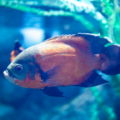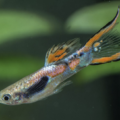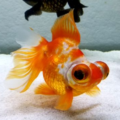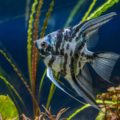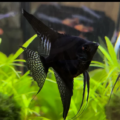Preserve the shimmery silver scales of the Platinum Angelfish with these premium care tips. This guide includes health care, breeding, tank setup, and compatibility needs for your new pets.

Discovering the Platinum Angelfish
Have you seen a shimmering aquarium fish with a stunning all-white appearance but don’t know its name? That’s the exotic Platinum Angelfish.
This species stands out even amongst ornamental fish because of its iridescent scales, which look like they’re dancing underwater. As a premium angelfish species, you can agree that the Platinum variant is worth reviewing.
Already, this elegant freshwater fish is highly sought after by collectors and enthusiasts alike due to its rarity and exceptional beauty, but what other features make it a high-value fish? You’re about to find out!
Origins and Selective Breeding
Firstly, you must know that there are two ways ornamental fish come into existence. It could be through selective breeding or them being natural-born stunners. As for the Platinum Angelfish origins, the answer is the former. They’re a result of careful genetic engineering.
Breeders sought ways to ensure the creation of platinum color skin, which makes this fish stand out from others.
Through various selective breeding techniques aimed at eliminating melanin production, they isolated desirable traits by gradually intensifying the platinum hue and discarding the Angelfish’s natural stripes and markings.
The result of this genetic selection in Angelfish is what you now know and love as the Platinum Angelfish.
Distinctive Physical Traits

If you want a sleek-bodied angelfish with long flowing fins and a shiny body sure to arrest everybody’s attention, then this is the one. The Platinum Angelfish traits are a testament to the wonders of selective breeding, resulting in a breathtakingly beautiful aquatic creature.
Let’s start with the coloration before talking about the body structure, size, and eye color.
The shiny, metallic white, and sometimes silver skin tone on this species is a unique coloration in fish because of its lack of markings. Although it grows up to 6 – 8 inches like other Angelfish with triangular lateral bodies, this variant also has a sleek finnage.
The Platinum angelfish fin beauty comes from having tapered, pointed, and long pectoral, dorsal, and anal fins, which allows it to glide elegantly through the waters. But that’s not all.
This shimmery Angelfish has piercing dark eyes contrasting its platinum skin color and creating a mesmerizing visual impact in any tank.
Its distinctive fish appearance sets it apart from other fish species, but this also means you must pay extra attention when caring for them.
Specialized Care Requirements
Platinum Angelfish care requires specialized attention to maintain their striking color, calm temperament, and optimal health. The best way to achieve this is by ensuring they exist in the best living conditions, eat the best food, get periodic health care, and have compatible tank mates.
Let’s start with the basic — Maintaining Optimal Water Quality.
Water Quality for Platinum Angelfish
Keep steady water quality with a slightly acidic pH level between 6.5 – 7.5, temperature between 78-82°F, and soft to moderate hardness. Make regular water changes of at least 20 – 30% weekly to filter waste and sediments from leftover food.
Proper Tank Lighting
Keeping lightning conditions moderate to low helps with maintaining the platinum hue we all love to see. You can shade the light with plants to prevent direct contact that can harm your pet’s skin.
Also, regulate the lighting so that it has a 12-hour day-to-night cycle that gives your Platinum Angelfish a sense of routine. This specialized care is to avoid hyperactivity, which can lead to stress, aggression, burnout, or worse, death of this species.
Constant light tells them they’re still in the day, so they’ll refuse to sleep when their bodies call for rest because they think it’s still okay to be active. So, help them create that ideal sleep routine.
Platinum Angelfish health management doesn’t end here, though. You still have to create the ideal tank environment in terms of decoration to give your pets a feel of home. Monitor their food intake and reaction to the environment you’ve created.
Ideal Tank Environment
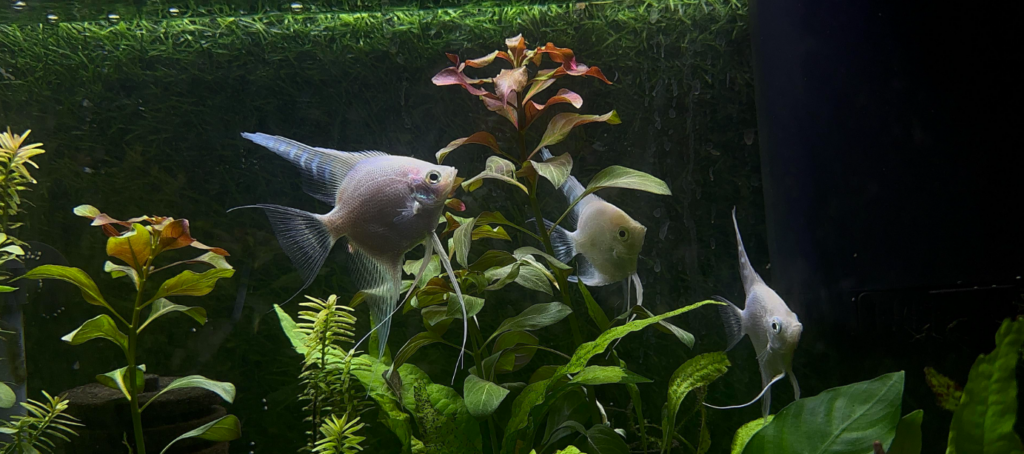
Ready for your Platinum Angelfish tank setup? Let’s Go!
Tank Size
Ensure you use a minimum 20-gallon tank with tall dimensions to accommodate the fish’s vertical swimming style.
Decoration and Substrate
When choosing compatible aquarium decor for your Platinum Angelfish, consider their natural habitat and physical traits. “How?” you may ask,
by using Amazon-like plants, whether live or artificial, rocks, caves, and sands to decorate the tank. But also select pieces with smooth edges and a soft feel to reduce the risk of skin injury to your Platinum Angelfish.
Filtration
Use effective filtration for health sustenance by maintaining favorable water parameters, as I’ve provided above. You may use a single or double-canister high-quality filter to speed up the nitrogen cycle and convert ammonia waste to nitrate and nitrite.
Ensure gentle water circulation to allow them to swim elegantly and showcase their striking appearance.
These Platinum angelfish habitat requirements put you a step closer to creating a thriving aquarium for your fish, but that’s not all. It’s time to discuss food intake.
Nutritional Guidelines and Feeding
Providing a balanced diet for fish is as important as maintaining optimal environmental conditions. I’ve summarized how you can sustain the required nutritional care for Angelfish in this guideline.
Nutritional Needs

Feed them protein sources like meaty foods for muscle development and strength. Maintain carbohydrate content and provide essential fatty acids for boosting skin and fin health. Examples of foods containing these nutrients include:
- Blanched vegetables like Zucchini, Peas, and Algae
- Commercial Pellets and Flakes
- Live food like Brine Shrimp and Daphnia
After settling on a Platinum Angelfish diet, you should also add vitamins and minerals specifically formulated to enhance angelfish health.
Try rotating foods regularly to provide more nutrients and provide a mix of sinking and floating foods to accommodate their natural feeding behavior.

For more on feeding your aquatic pets check out The Ultimate Guide to Fish Food: Pros and Cons & Best Choices!
Feeding Guidelines
Feed 2-3 times a day, in quantities they can consume within 1-2 minutes. It prevents overfeeding your fish and polluting the water with leftovers, as that can affect their health negatively.
By following this nutritional care for Angelfish, you are sure to meet the dietary needs that support fish health, but there’s also a tendency for genetic illnesses.
Health Considerations and Disease Prevention
Your Platinum Angelfish’s health will be fine if you feed them properly and with the right living conditions, but that doesn’t remove the possibility of illnesses.
While the guidelines I’ve shown you so far are good for disease prevention, here are some more tips to help you handle fish illnesses. I’ve created a short list of common diseases, their causes, symptoms, and treatment.
Fin Rot
Causes: Bacterial infection. Bacteria in aquarium tanks grow from poor water quality, untreated injury, or stress.
Common signs: Frayed, torn, or disintegrating fins. Redness and inflammation. Labored swimming.
Treatment: Improve water quality through regular changes and monitoring; administer antibiotics as prescribed by the vet.
Parasite Infections
Causes: contaminated water or contact with other infected fish.
Common signs: White spots, yellowish dust, labored breathing, lethargy.
Treatment: Quarantine infected fish, Increase water temperature, and administer anti-parasite medication as directed by your vet.
For more details checkout our article on How to Treat Ich Outbreaks in Your Freshwater Fish!
Fungal Infections
Causes: poor water quality, injury, or stress.
Common signs: Cotton-like growths, white or grayish patches, lethargy.
Treatment: Improve water quality through regular changes and monitoring. Administer anti-fungal medications under veterinary guidance and quarantine affected fish for treatment in a separate quarantine tank.
Preventive Measures
Here’s how you can easily prevent some of the Platinum Angelfish common ailments above:
- Maintain optimal water quality.
- Provide a balanced diet.
- Minimize stress by pairing your Platinum Angelfish with compatible tank mates.
These angelfish wellness tips will surely help you keep your Platinum Angelfish healthy and thriving.
Breeding Platinum Angelfish

The process of breeding Platinum Angelfish has several reproduction challenges because of their sensitive genetics.
Hence, for successful reproduction, you must pay attention to details by understanding the genetic complexity, selecting proper breeding pairs, maintaining optimal breeding conditions, and scheduling your time properly.
Selecting Breeding Pairs
Use healthy, mature fish at least 6-8 months old with desirable traits such as compatible size, color, and finnage. Ensure the pair you choose displays courtship behavior for compatibility so you don’t force breeding.
This video has been very helpful in identifying the sex of angelfish, I highly recommend it:
Setting up Breeding Conditions
Have a designated breeding tank using the same parameters as provided above. Create enough hiding places, plants, and visual barriers to reduce stress. Add a sponge filter or gentle filtration to prevent eggs from being sucked into the device.
Caring for the Fry
Your Platinum Angelfish fry will hatch within 2 – 3 days. Feed infusoria or newly hatched brine shrimp within the first 24-48 hours and gradually transition to larger foods as the fry grows. Remember to maintain water quality and monitor for diseases.
Conduct extensive research on genetic preservation in breeding to maintain the integrity of your Platinum Angelfish strain. Some tips to help you include:
- Avoiding inbreeding
- Selecting desirable traits
- Keeping accurate records.
By understanding these intricacies, you can overcome the challenges and put yourself closer to raising a healthy fry.
Behavior and Compatibility

Platinum Angelfish behavior is generally peaceful but can be territorial and fin-nippy. Pair them with small to medium-sized, gentle species that don’t compete for food or space.
When selecting compatible fish, avoid fish that the Angelfish may see as prey, such as fin-clipped or slow-swimming fish. Remember that decorations and maintaining decent water parameters are a necessity for maintaining a peaceful aquarium environment.
By paying attention to the compatibility of your fish in the community tank and creating a peaceful environment, you can enjoy a thriving community tank with this fish.
Conclusion
As you embark on the journey of aquarium care mastery, prepare for the joys and challenges. The Platinum angelfish’s serene beauty and majestic presence add a touch of sophistication to any aquarium setup.
You already know the benefits of keeping Angelfish.
By embracing the challenges and complexities of caring for Platinum Angelfish and following the premium fish care insights I’ve provided, you’ll be rewarded with a truly unique and captivating aquarium experience.
Keep at it to see the thrill of angelfish care excellence and the beauty of these premium aquatic companions.

